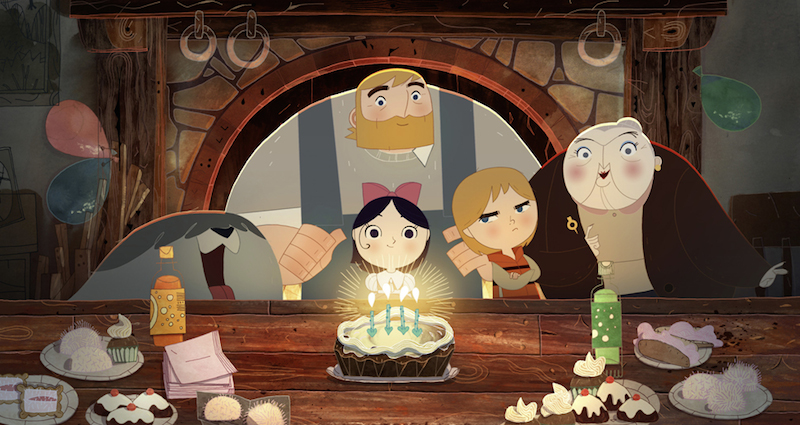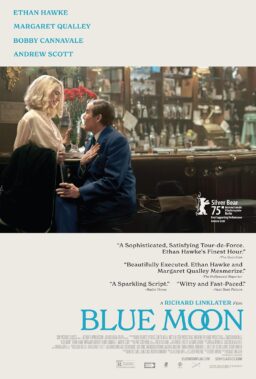Two movies at this year’s AFI Fest from opposite ends of the world—Ireland and Japan—had images that stayed with me. Both relate to legends of old, but only one is family-friendly: “Song of the Sea.” The other is a less perfect but still visually stunning film: Takashi Miike’s “Over Your Dead Body.”
If you loved the Academy Award-nominated “The Secret of Kells,” then you’ve probably been waiting for Tomm Moore’s latest feature, “Song of the Sea.” “The Secret of Kells” won the Audience Award at the 2009 Annecy International Animated Film Festival. Moore and his Cartoon Saloon embraced the limitations of 2D animation to bring us a stylized world based on traditional Irish designs, drawn from legends related to the Book of Kells, an illuminated manuscript Gospel book in Latin, believed to have been created in 800 A.D.
For “Song of the Sea,” Moore (original story) and Will Collins (screenplay) go back even further in Irish history and mythology for a delightful fictional work that brings these legends forward into contemporary times. I was able to preview this movie before Halloween, and wanted to add this to my list of favorite Halloween movies. The story is about a brother and sister, Ben (voiced by David Rawle) and Saoirse (Lucy O’Connell), whose father is a lighthouse keeper. The family lives on a small island that can only be reached by boat. Unbeknownst to Ben, their mother is a Selkie. Before she dies, the mother teaches Ben songs and gives him a seashell. Ben bitterly resents Saoirse because he blames her for their mother’s death.
Selkies are shapeshifters. In the sea, wearing their special coats, they are seals. On land, they become humans. Saoirse is the last Seal-child but her mother dies before she can teach Saoirse how to be a Selkie.
Saoirse follows her instincts and attempts to join the seals. Wearing her white Selkie coat, in one of the more lyrical segments, she swims with seals and sees a whale. What child wouldn’t want to find a magical white coat and dive into the cold deep water to see such wonders? Yet when her grandmother discovers her playing in the ocean, the grandmother demands things change.
Saoirse’s father remains in denial, and the grandmother insists that the children need to be in a safer place, off the island and away from the sea. She worries that Saoirse could drown, and why Saoirse still can’t speak.
The grandmother takes the children to the city where things are civilized and space is limited. That also means Ben must leave his dog behind. Ben records the landmarks on the journey, then Ben escapes, making his way home with his silent sister tagging behind.
Ben learns to be a more loving brother, discovers the reason for Saoirse’s silence, and faces his own fears. Yet there’s a bit of desperation to their plight; Saoirse must get her coat and Ben must teach her how to play the seashell and sing her song in order to save some of the mythical creatures from turning to stone.
Their journey happens on Halloween, and while other children are playing at being supernatural beings, Ben and Saoirse are meeting the real creatures of myths and legends. Besides the Selkies, Moore and Collins introduce us to the ancient Irish goddess Macha (Fionnula Flanagan), the ancient sea deity Mac Lir (Brendan Gleeson) and some little fairy folk who can play the fiddle fine as you like if they can keep from turning into stone. In this gentle world, no one is truly evil, not even Macha, whom the children at first are fighting against (and not even their grandmother who is voiced by the same actress).

In Miike’s world, evil does exist and it comes in many forms. In his “Over Your Dead Body,” he resurrects an old ghost story, Yotsuya Kaidan. The Japanese title is “Kuime” or “Eating Woman.” Yotsuya is an actual place in Tokyo. It is a stop on the well-used stop on the Chuo (Central) line. The ghost story originates from a 1825 kabuki play “Tōkaidō Yotsuya Kaidan” (東海道四谷怪談). The playwright Tsuruya Nanboku was inspired by two sensational murders–the murder of a master by his servant and the murder of an unfaithful wife by a samurai.
Nanboku wrote about a masterless samurai Tamiya Iemon who murders his father-in-law, but separates from his wife Oiwa after her face is disfigured by poison given to her by the parents of Oume, who has fallen in love with Iemon. Oiwa dies cursing Iemon and comes back to haunt him, tricking him into killing Oume. Even then, Oiwa isn’t satisfied and continues to haunt Iemon until he goes insane.
The story continues to inspire movie makers and playwrights. Miike embraces the theatrical origins of this tale by making this a backstage drama. A modern theater group has taken on a non-kabuki re-telling and the main actors are involved in an affair.
Kosuke (Ebizo Ichikawa) is involved with well-known actress Miyuki (Ko Shibasaki). She gets him a part as Iemon to her Oiwa. Kosuke becomes interested in his young co-star (Miho Nakanishi). The meta-drama here has been done before, but Miike adds his own touch, bringing in childhood fears of creepy crawly things: centipedes. The design of a centipede as a kamon (Japanese family crest) used on the many paper lanterns and on the noren (split curtain). The lighting makes it appear as if a large graphic image of a centipede is encircling a woman who will become a creature who eats babies and the embodiment of poisonous creepy crawly things that lurk in the humid summer nights.
Like me, you might be unfamiliar with centipedes. My first summer in Japan was filled with memories of cockroaches but not centipedes. The difference between carpet or wood floors and the traditional tatami mat floors, is that you can hear larger insects creeping around at night on tatami. Centipedes can drop in, from the ceiling. They are not just a nuisance and possible hygiene problem like cockroaches, but centipedes can deliver a painful bite. The venom of a centipede can cause swelling and redness, possibly nausea and vomiting. In Japanese folklore, a giant centipede tortures humans or eats baby dragons. Yet there is a town that honors them and people who honor the creature at a shrine (Sakagami) and others who use the centipede to make a balm for cuts and burns.
Perhaps if you grew up with the giant centipede as a boogieman or experienced a night time drop in from a vicious biting bug, the creep factor would be greater for Miike’s movie. I know tales of giant spiders or giant ants can make my skin crawl and when I was a kid, could give me nightmares. I can’t think of summer in Japan without memories of cockroaches flitting through my mind, and I never go into the local deserts without thinking about rattlesnakes and scorpions.
In both “Song of the Sea” and “Over Your Dead Body,” the filmmakers are bringing forward cultural touchstones, myths and legends and relating them to contemporary life. In “Song of the Sea,” Moore brings a nostalgic feel based on his memories of being a child in Ireland in the 1980s. Miike’s “Over Your Dead Body” exposes the universal ugliness of jealousy and unfaithfulness and has some gorgeously lit scenes that contrast the beauty of love against the bloody horror of revenge.
Moore has said that he was intrigued by how Hayao Miyazaki’s work offered insight into an unfamiliar culture while communicating universal themes. Coincidentally Miyazaki was in Hollywood receiving an honorary Oscar on the same day that “Song of the Sea” first screened. Moore blogged that he shook hands with Miyazaki and “meeting Miyazaki will be a lifetime highlight.” With “The Secret of the Kells” and now “Song of the Sea,” Moore will likely inspire young artists as well.
“Over Your Dead Body” is making the festival rounds. “Song of the Sea” will open on 19 December 2014 as a limited release and then expand for the holiday season.












